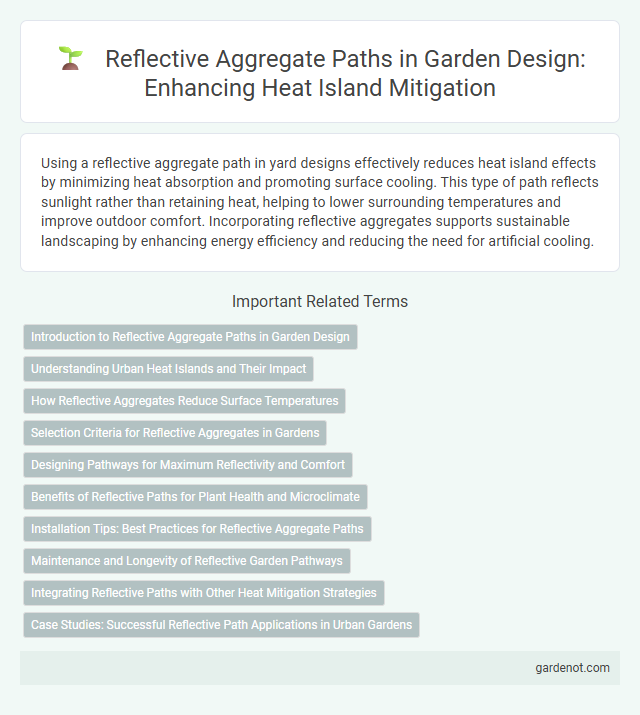Using a reflective aggregate path in yard designs effectively reduces heat island effects by minimizing heat absorption and promoting surface cooling. This type of path reflects sunlight rather than retaining heat, helping to lower surrounding temperatures and improve outdoor comfort. Incorporating reflective aggregates supports sustainable landscaping by enhancing energy efficiency and reducing the need for artificial cooling.
Introduction to Reflective Aggregate Paths in Garden Design
Reflective aggregate paths enhance garden design by utilizing light-colored, reflective materials that reduce heat absorption and lower surface temperatures. These paths contribute to mitigating urban heat islands by reflecting solar radiation, improving outdoor comfort and energy efficiency. Incorporating reflective aggregates complements sustainable landscaping strategies aimed at creating cooler, more inviting garden environments.
Understanding Urban Heat Islands and Their Impact
Reflective aggregate paths reduce heat absorption by using light-colored materials that reflect sunlight, directly mitigating urban heat island effects. Urban heat islands occur when built environments trap heat, increasing local temperatures and elevating energy consumption, health risks, and air pollution. Incorporating reflective aggregates in yard design can lower surface temperatures, improving microclimate conditions and enhancing urban heat island management.
How Reflective Aggregates Reduce Surface Temperatures
Reflective aggregates reduce surface temperatures by increasing the albedo effect, which reflects more solar radiation away from the ground compared to traditional materials. These aggregates minimize heat absorption and lower surface heat retention, effectively mitigating urban heat island impacts. By maintaining cooler surface temperatures, reflective aggregate paths contribute to enhanced pedestrian comfort and reduced cooling energy demand in surrounding areas.
Selection Criteria for Reflective Aggregates in Gardens
Reflective aggregates for heat island mitigation in garden paths must possess high solar reflectance to reduce surface temperature and enhance cooling effects. Selection criteria include light color, low thermal conductivity, and durability to withstand weathering and foot traffic. Aggregates such as quartz, marble chips, or light-colored granite are optimal for maintaining reflectivity and reducing urban heat accumulation.
Designing Pathways for Maximum Reflectivity and Comfort
Designing reflective aggregate pathways involves selecting light-colored, high-albedo materials that minimize heat absorption and enhance surface reflectivity to reduce urban heat island effects. Incorporating smooth textures and adequate shading improves pedestrian comfort by decreasing surface temperatures and glare. Proper drainage and stability ensure durability while maintaining a cool, inviting outdoor environment.
Benefits of Reflective Paths for Plant Health and Microclimate
Reflective aggregate paths significantly reduce ground surface temperatures, creating a cooler microclimate that supports plant health by minimizing heat stress and water evaporation. These paths enhance soil moisture retention and promote healthier root systems, leading to more resilient vegetation in urban heat island mitigation yards. By lowering ambient temperatures, reflective paths also improve air quality and contribute to a balanced local ecosystem.
Installation Tips: Best Practices for Reflective Aggregate Paths
For effective installation of reflective aggregate paths in heat island mitigation yards, ensure the sub-base is well-compacted and graded to promote proper drainage, preventing water pooling that can degrade reflectivity. Utilize white or light-colored aggregates with uniform size to maximize solar reflectance and durability. Regular maintenance, including periodic cleaning and replenishment of aggregates, preserves the path's reflective properties and extends its lifespan.
Maintenance and Longevity of Reflective Garden Pathways
Reflective aggregate paths enhance heat island mitigation by reducing surface temperatures through high albedo materials. Regular maintenance, including periodic cleaning and reapplication of sealants, ensures the reflective properties remain effective and extends the pathway's longevity. Proper drainage and prompt repair of cracks prevent degradation, preserving both functionality and aesthetic appeal over time.
Integrating Reflective Paths with Other Heat Mitigation Strategies
Integrating reflective aggregate paths with green infrastructure such as tree canopies and permeable pavements enhances overall urban heat island mitigation by reducing surface temperatures and increasing evapotranspiration. Combining reflective materials with shade-providing vegetation maximizes cooling effects while minimizing heat absorption on concrete surfaces. Optimizing design through strategic placement of reflective paths within shaded areas balances thermal comfort and sustainability in yard landscapes.
Case Studies: Successful Reflective Path Applications in Urban Gardens
Reflective aggregate paths in urban gardens have effectively reduced surface temperatures by up to 12degF, demonstrating significant heat island mitigation. Notable case studies include New York's High Line and Chicago's Millennium Park, where reflective materials lowered ambient heat and improved visitor comfort. These applications also decreased energy use for nearby buildings by enhancing natural cooling effects in densely built environments.
Reflective aggregate path Infographic

 gardenot.com
gardenot.com